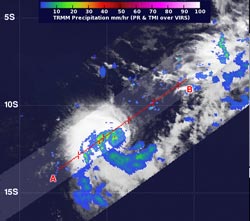NASA Sees Strength in Newborn Tropical Cyclone Emang

NASA's TRMM satellite captured rainfall rates in Tropical Storm Emang on Jan. 13 at 0404 UTC. Moderate (green) and heavy rainfall (red) was occurring around the center of circulation, where rainfall rates ranged from 30 mm (1.18 inches) to 50 mm (2 inches) per hour. Credit: NASA/SSAI Hal Pierce<br>
NASA's Tropical Rainfall Measuring Mission (TRMM) satellite captured rainfall rates in Tropical Storm Narelle on Jan. 13 at 0907 UTC (5:07 a.m. EST). Moderate and heavy rainfall was occurring around the center of circulation, where rainfall rates ranged from 30 mm (1.18 inches) to 50 mm (2 inches) per hour. That heavy rainfall is a sign that there is strong convection occurring within the storm, and forecasters at the Joint Typhoon Warning Center expect the storm will consolidate and organize more over the coming week.
On Monday, Jan. 14, at 0900 UTC (4 a.m. EST), Emang's maximum sustained winds were near 35 knots (40 mph/64.8 kph). Emang's center moved near 12.5 south latitude and 79.4 east longitude, about 500 nautical miles (575.4 miles/ 926 km) southeast of Diego Garcia. Emang was moving to the southwest at just 3 knots (3.4 mph/5.5 kph). Emang is located in is a weak steering environment. It is moving slowly under the influence of a building subtropical ridge (elongated area) of high pressure located to the south of the storm.
Monday's satellite data showed that the low-level center had now become fully exposed to outside winds, and there were shallow bands of thunderstorms around the northwestern edge of the storm. Emang is currently being battered with moderate (up to 20 knots/23 mph/37 kph) vertical wind shear.
Forecasters at the Joint Typhoon Warning Center expect improvements in environmental conditions which will improve the storm's organization. Emang is expected to slowly intensify over the next couple of days as it travels over open ocean. By the end of the week, Emang is expected to reach peak intensity as a cyclone of 65 knots (74.8 mph/120.4 kph).
Emang is currently not a threat to any land areas.
Text Credit: Rob Gutro
NASA's Goddard Space Flight Center, Greenbelt, Md.
Media Contact
All latest news from the category: Earth Sciences
Earth Sciences (also referred to as Geosciences), which deals with basic issues surrounding our planet, plays a vital role in the area of energy and raw materials supply.
Earth Sciences comprises subjects such as geology, geography, geological informatics, paleontology, mineralogy, petrography, crystallography, geophysics, geodesy, glaciology, cartography, photogrammetry, meteorology and seismology, early-warning systems, earthquake research and polar research.
Newest articles

Superradiant atoms could push the boundaries of how precisely time can be measured
Superradiant atoms can help us measure time more precisely than ever. In a new study, researchers from the University of Copenhagen present a new method for measuring the time interval,…

Ion thermoelectric conversion devices for near room temperature
The electrode sheet of the thermoelectric device consists of ionic hydrogel, which is sandwiched between the electrodes to form, and the Prussian blue on the electrode undergoes a redox reaction…

Zap Energy achieves 37-million-degree temperatures in a compact device
New publication reports record electron temperatures for a small-scale, sheared-flow-stabilized Z-pinch fusion device. In the nine decades since humans first produced fusion reactions, only a few fusion technologies have demonstrated…





















